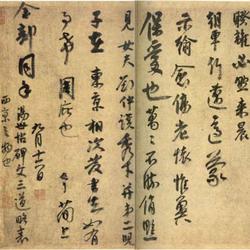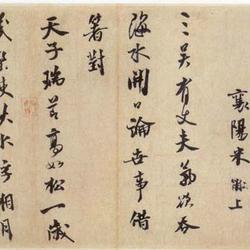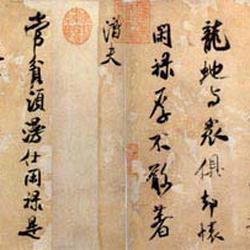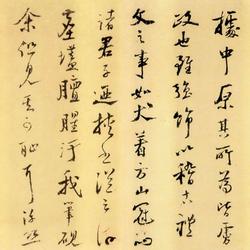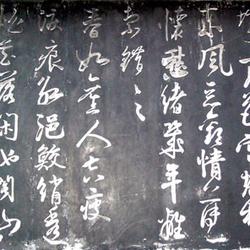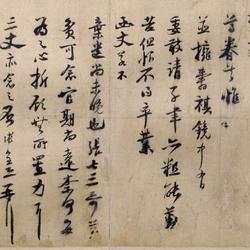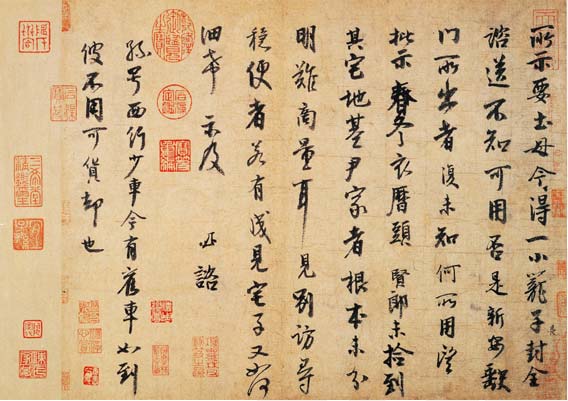
"Tu Mu Tie", running script, paper, 31.2 cm in length and 44.4 cm in width. There are ten lines, each line has a different number of words, a total of 104 words, collected by the National Palace Museum in Taipei (click to view the larger image)
Explanation:
I asked for a native mother, and now I have a small cage. I will give it to the whole family. I wonder if it can be used? This is what came out of the missing gate in Xin'an. I don't know what it will be used for. I hope you can give me some instructions. Spring and winter clothes have passed, and the wise man has not been inspected. The foundation of his house and the Yin family are not clear at all, making it difficult to discuss. If you meet someone who is looking for a safe place, what if you have a preconceived idea of the house? Please give me detailed information and advice. There are few cars on Sun's westbound journey. There are old cars now. If we don't use them when we get there, the goods will be gone.
This post was originally one of the "Liu Tie Juan" in Jianzhong. There is a number with the word "wei" between the two characters "zi" and "feng" in the lower corner of the first line. It was originally written by Xiang Yuanbian (zi Jing, molin) in the Ming Dynasty. ) hidden. According to "Daguanlu", the six posts are "Tumu Tie", "Tong Nian Tie", "Guizhai Tie", "Tuntian Tie", "Left and Right Tie" and "Zhaigu Tie".
Jianzhong experienced several periods in his life, including the Five Dynasties and the Song Dynasty. He is a connecting figure in the history of calligraphy. The style of Tang poetry often changed, although it was not caught up in the late period, but after three hundred years of writing, it still has the style and charm since Zhenguan and Yonghui. Although Jianzhong was founded in the early Song Dynasty, his calligraphy was not far away from the Tang Dynasty, and it still has the lingering style of the Tang Dynasty, reaching its peak in the transition period from the Five Dynasties to the Song Dynasty. The calligraphy world in the early Song Dynasty has shown a return to the Jin Dynasty, which started with Yang Ningshi, a calligrapher of the Five Dynasties, and Li Jianzhong, who had an influence on calligraphy in the early Song Dynasty. The calligraphy of Yang and Li both shows signs of tracing the Jin people and integrating the calligraphy styles of the Jin and Tang Dynasties. Later, Cai Xiang used his own ideas to integrate the calligraphy of Jin and Tang Dynasties into one furnace. He did not stick to one method but used it freely, and reached the state of "controlling the method with intention". From the Song Dynasty to Su Shi and Huang Tingjian, a great change began. The Tang Dynasty succeeded the Jin Dynasty, and then the Five Dynasties. It was only in the Song Dynasty that Shangyi's calligraphy style became truly mature.
Ouyang Xun of Jian Middle School is not cold and thin. He writes "Tumu Tie" in running script. He uses cursive writing for a few figures and uses the center of the pen. His writing is calm and steady, and his method is rigorous. He has won the charm of European calligraphy. The structure is dignified, the characters are mainly vertical and horizontal, and the characters are vertical and horizontal according to the situation, and the skills are skillful. The lines of the text are widely spaced, the letter spacing is widened, the flow is fresh and rich, the style is elegant, and the bearing is graceful. The lines between the words are appropriate, and the size, length, and density of the fonts are consistent. The lines are thick and thin, and the dry brush is used naturally. The character "ear" has a long and slender shape, with a hanging needle and a pen, and a slight tilt to the left. It has a unique charm and is a bit eye-catching in the whole article. The style of calligraphy is similar to that of the Tang and Five Dynasties. It catches up with the Jin Dynasty and is clear and round, with a full-scale posture, which is very similar to the writing style of the two kings. But it is still a little reserved. You can see that the calligraphy style of Jianzhong was in the early days of the Jin and Tang Dynasties and was not yet mature. However, it also contributed to the opening of the calligraphy of the Song Dynasty. Jianzhong has very little ink that has been handed down from generation to generation. This calligraphy is one of his best calligraphy strokes and will be cherished by later generations.

